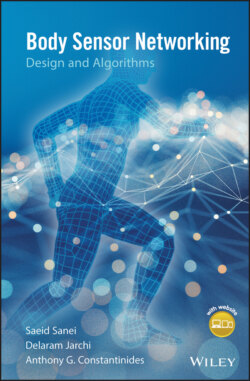Читать книгу Body Sensor Networking, Design and Algorithms - Saeid Sanei - Страница 35
3.3.2 Other Sensors
ОглавлениеOximeters are used to measure the blood oxygen saturation level (SpO2). The traditional measure of SpO2, called photoplethysmography, involves using two light beams in red and infrared wavelengths each sensitive to high and low blood oxygen levels respectively.
In principle, oximeters can operate in either transmissive or reflective mode. Those using an earlobe or finger measure the absorbed transmitted light through the tissue and others such as those used on the wrist work based on the reflective light by the tissue layers including the blood.
Figure 3.7 Electronic stethoscope; Littmann 3200 model.
In general, the SpO2 value is linearly dependent on the ratio between the transmitted infrared to red lights and decreases with this ratio. Figure 3.8 shows oximeters used in different modes of oximetry.
It is logical to accept that the oximeter reading is also an indicator of heart rate as the blood oxygen changes following the heart pumping cycle. Figure 3.9 shows two different oximeters with different recording modalities. The most important application of oximeters is in hospital intensive care units (ICUs) to ensure that the patient has normal breathing and heartbeat.
Amongst the other physiological measures, respiratory rate (RR) is important for the diagnosis of lung diseases and many other internal abnormalities. Therefore, it has an important role in healthcare and sport. In hospitals it is measured simply by the manual counting of breaths, conventional impedance pneumography, or an optical technique called end-tidal carbon dioxide (et-CO2).
Figure 3.8 Pictorial illustration of the concepts of transmissive and reflective oximetry.
Figure 3.9 Two different models of oximeters: (a) digital pulse oximeter used on the finger and (b) wireless wrist pulse oximeter, both from Viatom.
The impedance pneumograph is a bioimpedance recorder for indirect measurement of respiration. Using superficial thoracic electrodes, the system measures respiratory volume and rate through the relationship between respiratory depth and thoracic impedance change [41].
In the et-CO2 system, a device called a capnometer uses a small plastic tube inserted in the patient's mouth. The capnometer tube accumulates the expelled CO2 in each breath. An infrared light is then emitted to the CO2 from a moving source. Following absorption of infrared radiation overtime, a variation with breathing rate will be induced. The et-CO2-based systems are used in hospitals mainly for patients in critical conditions often within ICUs as well as ambulances for emergency checking of patient states. The capnographs, which look approximately like square waveform in normal conditions, significantly change during intubation, after cardiac arrest, ventilation problem, shock, emphysema, or leaking alveoli in pneumothorax, hypoxia due to asthma or mechanical obstruction, poor lung compliance, obese, and pregnancy [42].
Spirometry used for respiration monitoring is also one of the most common lung function tests. It measures the amount of air one can inhale and exhale. It also measures how fast the air can be emptied out of lungs. It is used to help diagnose breathing problems such as asthma and chronic obstructive pulmonary disease (COPD). During the test, the subject breathes in as much air as they can and then quickly blows as much air out as possible through a tube connected to a machine called a spirometer.
Body plethysmography is another common lung function test. It measures how much air is actually in the lungs when one inhales deeply. It also checks how much air remains in the lungs after they breathe out as much as they can. A plethysmograph has the same applications as a spirometer.
